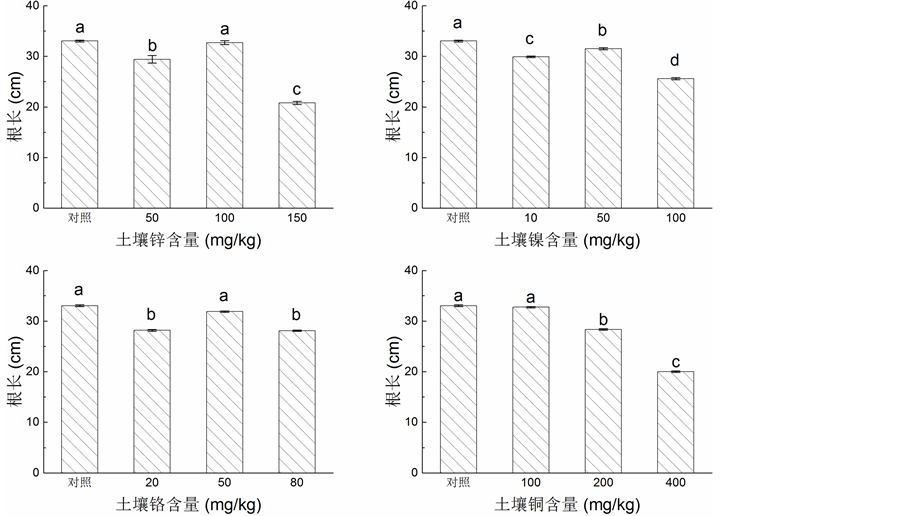摘要: 本文以重金属离子Cu
2+、Zn
2+、Ni
2+、Cr
6+为材料,以水晶生菜为研究对象,探讨了重金属胁迫对生菜的伤害机理及生菜对重金属胁迫的耐性机制。结果显示重金属对植物生长发育的影响体现在多个方面。例如Cu
2+对植物株高,叶面积、根长以及地下生物量的影响从低浓度就开始表现出抑制作用,随浓度增大抑制作用越发明显。Zn
2+、Ni
2+、Cr
6+对植物的影响整体看来表现出低浓度有促进作用,但随浓度增加表现出抑制作用,而且呈现正相关。生菜对重金属胁迫的敏感性在不同发育阶段也存在着明显的差异,以幼苗期最为敏感。
Abstract:
In this paper, Lactuca sativa was chosen as the focus plant species to test the injury mechanism of heavy metal stress, the tolerance mechanism of Lactuca sativa to heavy metals Cu2+, Zn2+, Ni2+, Cr6+ was also tested. The results showed that, heavy metals could show their injury effects on the growth and development of Lactuca sativa through different ways. For example, Cu2+ inhibited the height, leaf area, root length and biomass even when it’s in low concentration and, inhibition increased with the increase of concentration. However, Zn2+, Ni2+, Cr6+ promoted the growth of Lactuca sativa when they were in lower concentrations, while they inhibited the growth of Lactuca sativa when in higher concentrations, and the inhibition increased with the increase of concentration. Lactuca sativa showed different tolerance mechanism to heavy metals in different growth stages, and its seedlings were the most sensitive stage.
1. 引言
近年来,随着社会经济的快速发展,土壤中重金属含量不断增加,土壤重金属污染己成为普遍的环境问题,越来越受到人们的关注。2014年4月17日环境保护部和国土资源部联合发布了全国土壤污染状况调查公报,公报指出全国土壤环境状况总体不容乐观,部分地区土壤重金属污染较重。据统计,我国遭受不同程度重金属污染的耕地面积己接近2 × 105 km2,约占耕地总而积的1/5,每年因重金属污染导致的粮食减产超过1 × 107吨,被重金属污染的粮食多达1.2 × 107吨,合计经济损失至少200亿元 [1] 。土壤重金属污染不仅影响农作物生产,而且也影响大气和水环境质量,甚至通过食物链危害人类的健康。植物修复技术作为一种新兴的、高效的生物修复途径现已被科学界和政府部门认可和选用 [2] ,植物修复技术的关键是熟知植物在污染土壤中的生长过程及去除作用。因此,研究土壤重金属污染对植物生长的影响及植物生长对污染土壤的适应,能够为土壤重金属污染的生态修复提供理论依据。
土壤中的重金属污染源于采矿、冶炼、城市垃圾、化肥杂质和污水沉积物等。重金属在土壤中的高富集直接影响植物的生长和发育。因此,去除土壤和水体中的重金属已经成为了人类刻不容缓急需解决的问题。根据资料显示,某些重金属在植物中的含量不超过一定值的时候对植物生长有一定的促进作用 [3] ,而超过一定值的时候对植物的生长发育有相反的作用 [4] 。重金属离子对植物生长影响的研究较多 [5] ,但多数研究从是短期的实验,且多研究植物的生理状态 [5] ,对植物形态的变异研究较少,本实验通过研究重金属对生菜生长的影响以及生菜对重金属污染的抗逆性,探讨植物对重金属污染抗性的一般规律,从而为重金属污染的生态修复奠定基础。
2. 实验材料与方法
2.1. 盆栽试验
供试土壤为采自齐鲁工业大学苗圃,土壤经风干,粉碎后过3 mm筛备盆栽用。配制Cu2+、Zn2+、Ni2+、Cr6+四种金属的溶液,每种溶液设置三种浓度梯度,每个梯度设置5个重复(包括空白对照组)。具体浓度梯度如下:
Ni2+: 10 mg/kg 50 mg/kg 100 mg/kg
Zn2+: 50 mg/kg 100 mg/kg 150 mg/kg
Cu2+: 100 mg/kg 200 mg/kg 400 mg/kg
Cr6+: 20 mg/kg 50 mg/kg 80 mg/kg
混合均匀并加去离子水至70%田间持水量在室温下平衡1个月以备盆栽试验用。
供试作物为生菜。试验采用直径15 cm,高11 cm的培养盆,每盆装未加重金属离子的土或制备好的添加重金属离子的土1 kg,并施入定量缓释肥,每盆播种5粒,出苗后每盆定苗3株。在温室生长30 d后收获。
2.2. 取样方法
植株收获时,将土壤从花盆中倒出,用清水将根清洗干净,测量植物的株高、根长、叶面积;将植物分成地上和地下两部分,将植物放置于80℃烘箱内烘干至恒重,测单株地上生物量、地下生物量,并计算植株的根冠比。
2.3. 数据分析
重金属对生菜生长特征和生物量的影响效应采用one-way ANOVA分析,并对处理间的差异用Tukey test进行多重比较,方差分析用R的基础分析软件包,多重比较用R的multcomp软件包,文章图表用R的ggplot2软件包绘制。
3. 结果分析
3.1. 重金属污染对生菜株高的影响
株高是生菜形态发育状况和生理生化水平的直观表现。研究表明,植株受重金属单一污染后,株高随着污染浓度的上升呈先升后降的变化趋势。随着浓度的上升,各时期株高都先上升后下降,低浓度情况下,能促进植株的营养生长,株高增加。浓度高时,能抑制植株的营养生长,且浓度越高,抑制作用越强,株高越矮(图1)。重金属铜在浓度为100 mg/kg时就明显表现出对植物生长的抑制作用,且随着浓度的增加抑制作用越加明显,在浓度为400 mg/kg时,植物生长非常缓慢。重金属铬在浓度为20 mg/kg时没有明显表现出抑制或者促进作用。当浓度达到50 mg/kg时开始出现抑制现象,当达到80 mg/kg时抑制作用明显。重金属镍在浓度为10 mg/kg时,表现出较明显的促进植物生长作用。当浓度达到50 mg/kg时表现出抑制作用,100 mg/kg时抑制明显加重。重金属锌在浓度为50mg/kg时表现促进生菜生长的现象,当浓度为150 mg/kg时抑制明显(图1)。
3.2. 重金属污染对生菜根长的影响
根系是植物吸收养分的重要场所,植物的根系发达与否直接影响植物对营养物质的吸收,而植物吸收养分是决定植物生长情况的重要因素。根长能直接反映根系的发达程度,根系越长代表该根系越发达,根系越短代表该根系越不发达 [6] [7] [8] (图2)。实验结果表明,使用金属铜处理生菜时,当浓度达到100 mg/kg时就显示出对根长的抑制作用,随浓度升高后,抑制作用明显。使用金属铬处理生菜时,当浓度为20 mg/kg时表现出较明显的抑制作用,但是当浓度为50 mg/kg时,相较于20 mg/kg时,有促进作用,当浓度达到80 mg/kg时,表现出较明显的抑制作用。金属镍和金属锌表现出来的现象与铬相似(图2)。
3.3. 重金属污染对生菜叶面积的影响
叶片是植物进行光合作用、蒸腾作用等生理过程的主要器官,叶面积的消长是衡量个体生长发育好坏的重要指标。实验结果表明,随金属铬浓度的上升,叶面积呈先上升后下降的趋势,与株高基本相似。可能是低浓度铬能促进生菜地上部生长,浓度继续升高后,铬的毒害加大,叶面积呈下降的趋势。还发现,第1~2叶的叶面积变化较为平缓,从对照到最高浓度相差无几,原因可能是第1、2叶抽出时,土壤中的铬离子只有少许进入幼叶中,对生菜幼叶的危害还比较小,而第3、4、5叶抽出时,铬毒害的抑制

Figure 1. The effects of heavy metals on height of Lactuca sativa
图1. 重金属污染对生菜株高的影响

Figure 2. The effects of heavy metals on root length of Lactuca sativa
图2. 重金属污染对生菜根长的影响
作用己明显表现出来,高浓度时,叶面积自然就会下降 [9] [10] [11] 。随铜离子浓度的上升,第1~5叶的叶面积出现了持续下降的趋势,尤其在高浓度铜胁迫浓度下下降更为迅速,浓度达到400 mg/kg土时,叶面积只有原来的一半,这说明高浓度的铜胁迫对生菜的抑制作用非常大。叶面积受抑后生菜的营养生长得不到足够的光合产物,导致株型矮小,叶片黄化。锌胁迫条件下各处理的叶面积均随锌浓度的上升而呈下降的趋势,第1~2叶下降趋势较为平缓,而第3~5叶下降趋较为迅速(图3)。
3.4. 重金属污染对生菜地上生物量的影响
地上生物量主要代表该作物的产量,对于农业的发展有很大的影响。研究生菜的地上生物量可以综合其他几项理化性质的现象,更为直观的表示该植物的生长状况 [10] 。实验结果表明,Cu2+、Zn2+、Ni2+、Cr6+单一污染对生菜地上生物量的影响有以下三种趋势:① 随着Cr6+处理浓度的增加其地上生物量呈现下降趋势;② 随着Cu2+,Zn2+处理浓度的增加其地上生物量呈现先升后降的趋势;③ 随着Ni处理浓度的增加其地上生物量呈现出缓慢上升趋势。综上所述,当Cu2+,Zn2+处理时,生菜产量呈现出上升趋势,说明在此浓度范围内,重金属元素Cu2+,Zn2+促进生菜的生长,故Cu2+、Zn2+的上限值可作为种植生菜的临界值;但超出此临界值时,Cu2+、Zn2+将对生菜产生毒害作用,显著地抑制了生菜的生长。用Cr6+处理生菜表现出明显的抑制趋势,但是在浓度小于100 mg/kg时其减产程度较小,说明在此处理水平时重金属对生菜的生长虽然产生了一定的影响,但并没有达到毒害的程度,故可以将100 mg/kg作为种植生菜的临界值。通过比较分析各种处理水平对生菜地上生物量的影响,可见对株高和地上生物量的影响趋势更为一致 [11] [12] [13] (图4)。
3.5. 重金属污染对生菜地下生物量的影响
实验结果表明,Cu2+小于100 mg/kg,Cr6+小于50 mg/kg,Ni2+小于50 mg/kg,Zn2+小于100 mg/kg的生菜地下生物量均高于对照,其它各处理的地下生物量均低于对照。与单一重金属对生菜地上生物量的影响相比较,其趋势相一致,但对生菜根系的影响程度较少,在一定浓度范围还可以促进其根系的生长,可见生菜地下部对重金属的抗性要大于地上部(图5)。
4. 讨论与结论
四种重金属中只有铜为植物生长中的必需元素,有许多文献 [3] [4] [5] 也报道了低浓度铜对植物生长

Figure 3. The effects of heavy metals on leaf area of Lactuca sativa
图3. 重金属污染对生菜叶面积的影响

Figure 4. The effects of heavy metals on up-ground biomass of Lactuca sativa
图4. 重金属污染对生菜地上生物量的影响

Figure 5. The effect of heavy metals on under-ground biomass of Lactuca sativa
图5. 重金属污染对生菜地下生物量的影响
的促进作用,如铜可促进植物根、枝、花等器官的分化,但过量的铜却会对植物造成伤害。镍、铬被认为是生物体的非必需元素,它们在生物圈中的存在常常会给植物生长带来负效应。本试验以生菜为材料研究发现:四种重金属胁迫均能影响生菜前期的营养生长,使生菜的根长下降,株高也下降,进而使后期的植物干重随浓度上升而下降。此外高浓度重金属胁迫也使各处理叶绿素含量和叶面积下降,降低了高浓度处理下叶片的光合能力和光合叶面积,使高浓度处理前期形成的光合产物远低于对照和低浓度处理形成的光合产物。进而使高浓度处理在前期形成不了足够的生物量。这样即使后期养分再充足,灌浆速率再高,形成较高的经济系数,也形成不了较高的经济产量,这是重金属离子浓度上升而生菜经济产量下降的原因 [14] 。
就不同发育阶段而言,生菜对重金属胁迫的敏感性存在着明显的差异。从生物学指标来看,幼苗期生菜对重金属胁迫的抑制敏感性明显高于其他时期,这可能是由于幼苗生长缓慢,体内重金属的含量相对较高,而趋近成熟后,由于生长速度的加快,生物量的急剧增大导致体内重金属浓度受到一定程度的稀释,从而导致对生长发育抑制的缓解 [15] 。
重金属胁迫下,随金属离子浓度的上升,各处理根长、芽长均能显著或极显著的下降,而四种金属中铜胁迫对生菜根数的影响不存在双重性现象,即随浓度升高一直下降,上述变化趋势说明,对生菜而言,铜的综合伤害最大 (既能影响发根、发芽,又能影响根量),金属锌和铬的综合伤害最小,其胁迫下各处理根长、芽长下降幅度均明显小于其它两种重金属胁迫,根数基本不受影响,因此当前的环境污染治理中,应首当其冲的治理铜的污染,当然其他金属污染的治理也不容忽视。
基金项目
项目得到“齐鲁工业大学大学生创新创业训练计划项目资助项目”的资助。项目编号201510431027。